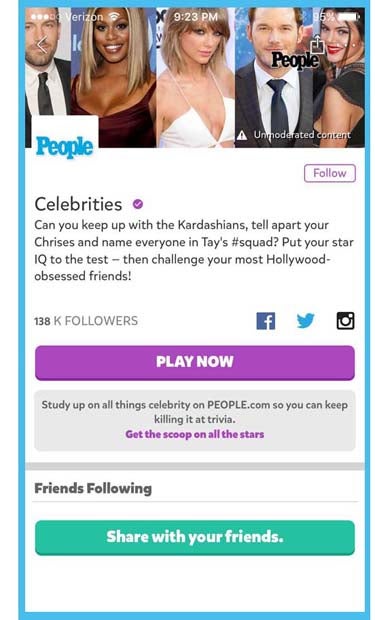 Why did Time Inc. decide to partner with Etermax, the Buenos Aires-based game studio responsible for the hugely popular app Trivia Crack?
Why did Time Inc. decide to partner with Etermax, the Buenos Aires-based game studio responsible for the hugely popular app Trivia Crack?
a) as a native play
b) as a form of content discovery
c) to encourage mobile engagement
d) all of the above
The answer: d.
“We’re quickly evolving from being a print company to a content and audience company,” said Steven Haft, SVP of innovation at Time Inc. “Like most publishers today, more than half of our digital audience is coming from mobile devices, and if we want to reach those people, we have to make our content available wherever they are.”
When Haft came on board in June 2014, right as Time Inc. was completing its spinoff from Time Warner, he found a disorganized amalgamation of legacy technologies, seven different CRM systems and no APIs. Since then, he and his team have been looking to put Time Inc.’s digital house in order – to “get all of our digital parts speaking the same language,” Haft said.
Around five months ago, each of its 24 US brands got its own API – a vital foundational block if Time wants to enable its brands to form mobile partnerships.
“The real story about Time Inc. is a company making strides in its digital infancy,” Haft said.
Digital is, in fact, a bright spot for Time. Although the company saw total revenues fall 6% year over year in the third quarter of 2015 to $773 million, down from $821 million, digital ad revenue showed a respectable 22% increase from $65 million to $79 million.
Digital poses challenges, of course, as audiences become increasingly fragmented – but they coalesce around particular experiences. Gaming is one of them.
Etermax has a track record for pulling in massive audiences. The studio’s flagship app, Trivia Crack, which allows players to test their trivia knowledge in bouts with friends or random people around the world, has around 200 million downloads.
In December 2014, a little over a year after its initial release, Trivia Crack became the most downloaded app in Apple’s App Store. Although Trivia Crack commanded an audience of around 200 million daily active users in its heyday, 100 million people still return to play daily more than two years after launch.
Time’s partnership with Etermax revolves around the sequel Trivia Crack Kingdoms, which Etermax CEO Maximo Cavazzani said has had 300,000 downloads per day since its Oct. 13 release.
Time wrote 12,000 questions related to its brands – including Sports Illustrated, People Magazine, Food & Wine, Fortune, Travel+Leisure, In-Style and Entertainment Weekly – and uploaded them to Trivia Crack Kingdoms under channel headings, including “Fashion” (In-Style), “Entertainment” (Entertainment Weekly) and “News” (TIME).
The channels that users follow and engage with – football, cooking, “Game of Thrones” – gives Etermax’s brand partners insight into their interests, data which Cavazzani said can be used to target ads.
Although ad targeting is one potential, Time Inc. is still mulling what form its advertiser relationships will take. It’s considering sponsored channels and brand-related trivia questions integrated into Time’s existing channels – but what’s for certain is that ads will not come at the expense of user experience.
 “Our goal is Trivia Crack’s goal, and that’s to keep people in the game and playing,” Haft said. “At the end of the day, we conceive this as a way to use our content, and perhaps a brand’s content, to reach a large, engaged audience. But we won’t do anything to destroy the flow and delight of the gameplay itself.”
“Our goal is Trivia Crack’s goal, and that’s to keep people in the game and playing,” Haft said. “At the end of the day, we conceive this as a way to use our content, and perhaps a brand’s content, to reach a large, engaged audience. But we won’t do anything to destroy the flow and delight of the gameplay itself.”
Cavazzani’s ambition for Trivia Crack Kingdoms is to become a sort of next-generation Twitter, a platform where users can create, distribute and engage with short-form content.
“And when information comes in the form of a question, when it comes in the form of a game, it also sinks more deeply into a user’s mind,” Cavazzani said.
Which is a large part of the appeal for Time.
“Sharing is an ephemeral experience for most people; they don’t read what they share, they just share based on a headline or a photo,” Haft said. “If I’m measuring success based on engagement, there’s clearly going to be more engagement with a Q&A than a tweet.”
Time, Inc.’s Twitter content actually provided what Haft called the “aha moment” that led to the Etermax hookup.
“There’s actually very little difference between breaking down our content into 140-character snippets and making a piece of our content into a short Q&A,” Haft said.
In terms of audience, Haft shrugs off any notion that gaming apps can’t be aligned with core brand KPIs like awareness, loyalty and overall engagement.
“Only millennials play games or only boys play games? No. We need to stay away from soundbites and look to see who’s actually playing – it’s everyone,” Haft said. “The sheer volume of people coming back to Trivia Crack every day is not something you get on publishing platforms. We’re still ramping up – it’s only been about three weeks – but I expect hundreds of millions of engagements with our content on a weekly basis.”
In addition to Time Inc., Etermax has inked deals with iHeartRadio, Oreo, Comcast NBC, Six Flags Theme Parks, Nickelodeon and Sony Pictures Entertainment, which created a “Goosebumps”-themed channel on Trivia Crack Kingdoms to promote the release of its upcoming movie.












